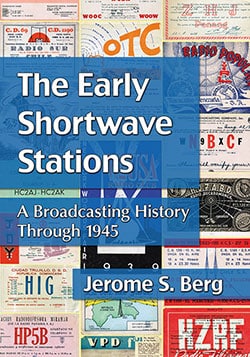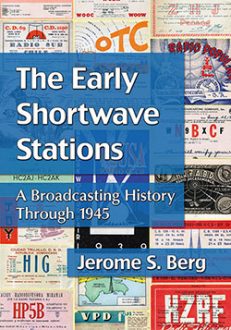The Early Shortwave Stations
A Broadcasting History Through 1945
$39.95
In stock
About the Book
In July 1923, less than three years after Westinghouse station KDKA signed on, company engineer Frank Conrad began regular simulcasting of its programs on a frequency in the newly-discovered shortwave range. It was an important event in a technological revolution that would make dependable worldwide radio communication possible for the first time. In subsequent years, countless stations in practically all countries followed suit, taking to shortwave to extend reception domestically or reach audiences thousands of miles away. Shortwave broadcasting would also have an important role in World War II and in the Cold War.
In this, his fourth book on shortwave broadcast history, the author revisits the period of his earlier work, On the Short Waves, 1923–1945, and focuses on the stations that were on the air in those early days. The year-by-year account chronicles the birth and operation of the large international broadcasters, as well as the numerous smaller stations that were a great attraction to the DXers, or long-distance radio enthusiasts, of the time. With more than 100 illustrations and extensive notes, bibliography and index, the book is also a valuable starting point for further study and research.
About the Author(s)
Bibliographic Details
Jerome S. Berg
Format: softcover (7 x 10)
Pages: 340
Bibliographic Info: 118 photos, appendix, notes, bibliography, index
Copyright Date: 2013
pISBN: 978-0-7864-7411-0
eISBN: 978-1-4766-0474-9
Imprint: McFarland
Table of Contents
Table of Contents
Preface 1
Glossary 3
1. Prelude to Shortwave 5
2. 1923–1929 20
3. 1930–1939 76
4. 1940–1945 197
Conclusion 281
Appendix: Nations and Stations 285
Chapter Notes 293
Bibliography 311
Index 323
Book Reviews & Awards
“recommended”—Choice; “terrific and highly recommended…should be in every radio listener’s library…an amazing excursion into the very early days of shortwave broadcasting development…a historical masterpiece…‘must read’”—The NASWA Journal; “Berg writes great radio history. Jerry has now detailed the history of short-wave radio definitively, with this fourth of four books. Every radio history enthusiast should own these books. We owe a debt of gratitude to Jerry Berg for documenting this age and telling its stories so well”—Antique Radio Classified; “Cox writes in an engaging way with oodles of examples to illustrate key points…invaluable history of shortwave radio broadcasting. Berg establishes himself as the authority on such broadcasting”—Journalism & Mass Communication Quarterly; “fascinating reading”—ARRL; “invaluable history…an excellent and readable record…extensive documentation…valuable”—Communication Booknotes Quarterly; “has more detailed information on specific short wave stations from the early period than you will find in any other single volume anywhere. This book is an unparalleled source of information on shortwave broadcast stations…constitutes a classic reference book on the subject…valuable…truly a great book. You will not be disappointed. This is one fine book”—The AWA Journal; “well-written, authoritative…Berg is, without a doubt, one of the foremost historians of shortwave radio broadcasting and listening…completely encapsulates early shortwave broadcasting history”—The SWLing Post; “this is a fastidiously-researched book. It is one to be read, treasured, and referred to often…this is one heck of a work. Let’s hope it’s not Jerry Berg’s last”—CQ plus; “a meticulous account of the rise of international broadcasting…heavily illustrated with numerous photos, QSL cards and letters…an extensive appendix…well indexed”—The Spectrum Monitor; “monumental…has set a standard of excellence…worthy of attention by all international radio monitors…recommend[ed]”—Wavescan; “written in a straightforward chronological style, the book includes some great photos and plenty of fun QSL cards. Any shortwave enthusiast or radio history buff would enjoy it”—RadioWorld; “valuable”—Monitoring Times.





